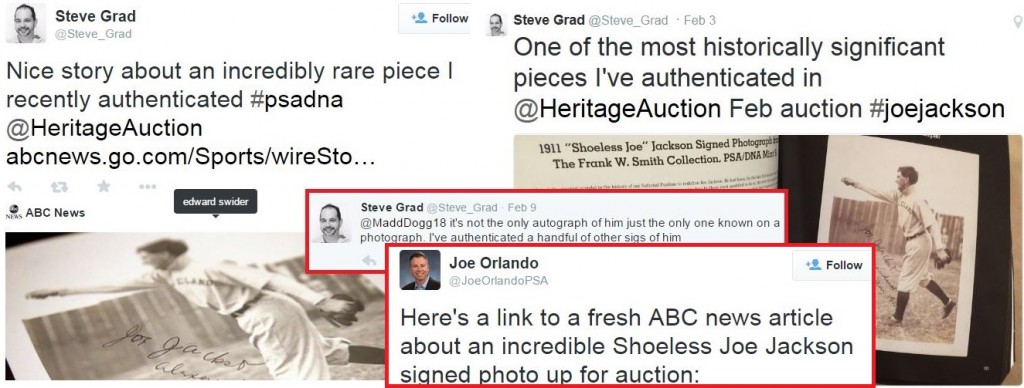February 18, 2015
| Image may be NSFW. Clik here to view.  |
Scroll to Bottom for Update:
“Shoeless” Joe seemed to be everywhere last week blowing up Twitter and making the rounds on the nightly news. As reported by the likes of ABC News, CBS News and FoxSports, Heritage Auction Galleries in Dallas, Texas, is selling what Sports Auction Director Chris Ivy claims is “now known as the only “Shoeless” Joe Jackson signed photograph in existence.” Reporter John Seewer first interviewed Ivy for the Associated Press and his story subsequently hit the wire and was later carried by hundreds of news outlets without mentioning that another alleged Jackson-signed photograph was sold by Sotheby’s for $43,000 in 1999 and was authenticated by Heritage’s current consignment director, Mike Gutierrez. Heritage and Ivy did not disclose any of this information to the Associated Press reporter and despite PSA/DNA President Joe Orlando telling the AP his company’s job is “to be the skeptic, especially if it is too good to be true,” other experts in the field believe that the Jackson signature is not genuine.
Ron Keurajian, the author of Baseball Hall of Fame Autographs: A Reference Guide has a very different opinion about the Heritage offering and told us, “I have maintained that there are no Joe Jackson signed photographs in existence. After viewing the 1911 Jackson photograph I see no reason to change my opinion. The Dallas Police Department should be made aware of the pending sale.” Keurajian’s opinion that Jackson signed photos do not exist was published in his book which was released by McFarland in 2012.
In January, Chris Ivy appeared on the TV-show A Piece of the Game and in direct opposition to Keurajian’s published opinion described the Jackson photo as “the only signed Joe Jackson photo in existence” and the work of a photographer named Frank W. Smith. But the other Jackson photograph that was sold at Sotheby’s in 1999 was also taken by the same photographer who was working for the Cleveland Plain Dealer and Leader and had utilized similar images of the Cleveland Naps players to create a composite photograph depicting all of their signatures—including Joe Jackson. When Heritage Auctions revealed their autographed photo collection to attendees of last year’s National Convention in Cleveland, they sourced the “find” of signed 1911 Cleveland photographs to the family of Frank W. Smith. However, as revealed in the AP report, the consignor is actually a woman named Sharon Bowen who claims her late husband, William Bowen, purchased the photos from a family that was allegedly friends with Smith. Heritage’s current catalog describes the collection as “Named for the Cleveland Plain Dealer photographer who assembled the remarkable collection, The Frank W. Smith Collection is a truly peerless amalgamation of one-of-a-kind vintage photography and the flawless autographs of the subjects captured.” Heritage’s of the collection adds:
“Among the targets of Smith’s lens and autograph requests appear some of the true immortals of the game, most notably the legendary “Shoeless Joe” Jackson, the illiterate superstar whose path to Hall of Fame immortality was derailed by the scandal of the 1919 World Series fix. His labored pencil signature on Smith’s skilled portrait establishes the pristine relic as the only known Joe Jackson signed photo in existence.”
Clik here to view.

Heritage is offering what they call "The Frank W. Smith Collection" featuring an alleged pencil-signature of Shoeless Joe Jackson on one of his 1911 photographs. The Jackson photo was one of dozens found in a photo album allegedly discovered in a barn outside Cleveland.
Although it’s not specifically noted in the actual lot description, Heritage reveals that its alleged Jackson signature is signed in pencil and, as reported in the past week, several experts have questioned the autograph’s authenticity. The pencil signature is uncharacteristically over-sized and takes up a good portion of the 8×10 silver gelatin photograph—all red flags that any handwriting expert would take into account before rendering an opinion. The AP report also states that PSA examined the pen pressure to render its opinion when the actual photograph was signed in pencil and would leave a much different impression than a steel-tipped pen. In addition, the Heritage signature starkly contrasts the Jackson signatures executed on the Sotheby’s photo shot by Smith and on the 1912 team composite photograph which was also featured as a supplement to the Cleveland Leader newspaper in 1912. The signatures included on Smith’s 1912 composite resemble the actual handwriting of the players depicted including many of the same players appearing in Heritage’s photo album.
Clik here to view.

Photographer Frank W. Smith created a composite cabinet photo of the 1912 Cleveland team featuring the signatures of each player. The composite was published as a supplement to the "Cleveland Leader" and credited to Smith (right). The composites show facsimile signatures of Joe Jackson, Nap Lajoie and other Cleveland players.
The fact that Heritage did not acknowledge or inform its bidders of a very public sale of another alleged signed Jackson photograph at Sotheby’s is troubling considering its consignment director, Mike Gutierrez, authenticated all of the autographed items for the 1999 Sotheby’s sale of the Barry Halper Collection. That same Jackson photograph was also known by Gutierrez and other authenticators five years earlier when it was sold at Robert Edward Auctions in 1994 a year after this writer purchased it at Lelands as a photograph “signed by his wife.” It was purchased for $1,200 (which Lelands says was once owned by sportswriter Gene Schoor) with no expectation it had been signed by Jackson, but when world renowned handwriting expert Charles Hamilton examined the photo in person he claimed it was a genuine Jackson signature.
Clik here to view.

The Jackson signature which appears on Frank W. Smith's 1912 Cleveland team composite (top left) is similar to another ink-signed portrait also taken by Smith and sold at Sotheby's in 1999 (top right). Heritage's alleged Jackson pencil-signature on a 1911 Smith photograph starkly contrasts the signatures on the Smith composites.
Hamilton stated that the signature had been enhanced with what he called “photographer’s ink” used by newspapers to darken signatures for publication. At the time in 1993 I was working with Hamilton and co-writing a reference book on baseball autographs and we had both just examined copies of the first authentic Jackson signatures found on promissory notes sourced back to Jackson relatives and friends. Hamilton told me he believed that underneath the black photographers ink he might find Jackson’s genuine signature and asked if he could use an eraser to lightly remove the covering. When he was finished the original purple-tinted ink that had been applied to the photo in 1912 was revealed.
After examining the signature closely and comparing it to the signatures on the mortgage notes Hamilton stated his opinion that the signature was executed in Jackson’s hand. Hamilton also noted the fact that the signature was clearly much more uniform and neat than the other signatures he had compared it to but he still identified the scrawl as the product of Jackson’s hand. Hamilton was also aware that the Jackson portrait was part of a larger composite that was likely published due to the presence of the photographer’s ink that was most likely applied by the photographer Frank W. Smith or someone in his employ.
Clik here to view.

The 1912 Jackson photo by Smith was sold at Lelands in 1993 as Mrs. Jackson's signature (top left). Charles Hamilton authenticated the signature as Jackson's own in a certification signed in March of 1994 (top right). The photo was then sold to collector Barry Halper (bottom right) in a REA sale in Sept. of 1994 (bottom left).
In March of 1994, Hamilton wrote a certification stating that the Jackson signature was “an authentic, original signature of Jackson” and “entirely different from the signatures signed for Jackson by his wife.” Hamilton added, “Every single letter is different, and matches very closely the signatures known to be genuine on his orders to pay dated from Savannah, Ga.” Later, in September of 1994, I consigned the photograph to Rob Lifson and Robert Edward Auctions where it was described as “the only unquestionably authentic Joe Jackson autograph in existence” and was sold to Lifson’s top client and New York Yankee minority partner Barry Halper. Lifson further described the Jackson portrait as “the most astounding of all autographed baseball photographs and one of the most incredible “find” stories of all time.”
The surviving 1912 team composite created by Smith featured all of the signatures of the Cleveland team and it is interesting to note that the surviving cabinet photo he created in 1912 has a very similar (almost identical) portrait of Jackson with a similar signature that has clearly been enhanced with the same type of photographer’s ink. It is important to note that the photo Halper purchased in 1994 and the Heritage Jackson photo being sold in 2014 are both sourced to Frank W. Smith and although they were allegedly executed within one year of each other, they look totally different.
Clik here to view.

The REA-Sotheby's Jackson signature (left) and the current Heritage offering (right) contrast some of the earliest genuine signatures executed by Jackson from 1914 to 1917.
Ron Keurajian, however, disagrees with Hamilton’s opinion and stated such in his 2012 book where he says he has never seen an authentic photograph signed by Jackson. In our interview with Keurajian last week he confirmed his opinion and extended it to the current photograph of Jackson being offered by Heritage. In offering his dissenting opinion of both photographs he is disputing the authentications of the deceased Hamilton, one of the most prominent handwriting experts of all time, and Steve Grad, the lead authenticator for PSA/DNA a subsidiary of the public company Collectors Universe and the current on-air expert used by the History Channel’s hit Cable-TV show Pawn Stars.
Grad and PSA/DNA, along with Heritage, also appear to be disputing Hamilton’s opinion in that they claim the current auction lot is the only signed Jackson photo in existence. Although former PSA/DNA authenticator and current Heritage consignment director Mike Gutierrez rubber-stamped Hamilton’s opinion for Sotheby’s in 1999 to facilitate a $43,000 sale for Barry Halper—PSA and Grad have made public statements dismissing the existence of the well-documented artifact.
Comparing Grad’s skills as an authenticator to Charles Hamilton, however, is almost impossible to do. In his 1996 New York Times obituary Hamilton was credited with “inventing the term philography” and was said to have authored 17 books on handwriting analysis and autographs. In the early 1990s several baseball collectors had Hamilton examine their collections and he uncovered scores of forgeries that had been authenticated by current Heritage employees Mike Gutierrez and Mark Jordan.
Clik here to view.

The late handwriting expert Charles Hamilton (left) advertised in Sports Collectors Digest in 1996. Steve Grad (center) is the lead authenticator at PSA/DNA. In his book "Baseball Hall of Fame Autographs" (right) Ron Keurajian says that Joe Jackson signed photos are non-existent.
Although Hamilton’s experience with baseball material was limited, he was recognized throughout the world as the leading handwriting expert who had uncovered frauds including the “Hitler Diaries” and worked with law enforcement on the “Zodiac Killer” and “Son of Sam” cases. Steve Grad’s claim to fame is his experience chasing celebrities and athletes down for in-person autographs and for being mentored by former hobby kingpin Bill Mastro who recently plead guilty to auction fraud and is awaiting sentencing in March. In a 2011 deposition Grad admitted he had no formal training in handwriting analysis and credited Mastro with training him as an authenticator and teaching him how to spot fakes and forgeries. In the same deposition Grad confirmed that he had fabricated his professional resume as he lied under oath about his educational background claiming to be a college graduate when, in fact, he is not.
In further contrast to Grad’s background, Ron Keurajian is a well-respected portfolio manager and attorney who does not work professionally as an authenticator but has dedicated several decades of his life to the study and analysis of baseball and historical autographs and handwriting. In addition to publishing the most comprehensive work dedicated to the handwriting and autographs of Baseball Hall of Famers Keurajian is currently working on his second book dedicated to historical autographs in every major field of interest. Keurajian is also credited with uncovering several major frauds including the exposing a forged Ty Cobb diary that was purchased by MLB and displayed at the Baseball Hall of Fame as well as many other bogus autographs that had been certified genuine by PSA/DNA including laser copy and auto-pen signatures. The most egregious errors and instances of authentication malpractice committed by Grad and PSA have been documented in Hauls of Shame’s 2013 Worst 100 authentication blunders report. In light of these very public blunders by Grad and PSA many collectors of high-end materials seek out Keurajan’s opinion and put little faith in the LOA’s issued by PSA/DNA. One of the top autograph collectors in the country told Hauls of Shame yesterday that he would not be bidding on the Jackson photo based on Keurajian’s opinion.
Clik here to view.

The authenticity of the Christy Mathewson signature in the Frank Smith Collection has also been challenged by experts. Above the Heritage Matty signature is displayed next to authentic Mathewson signatures ranging from 1908 through the teens.
Keurajian isn’t the only autograph aficionado who has questioned the authenticity of the Jackson photos and the balance of photographs in Heritage’s Frank W. Smith Collection. Several veteran dealers and collectors told us they questioned the authenticity of the photos signed by Hall of Famers Christy Mathewson, John McGraw, Nap Lajoie and Rube Marquard. In particular, the alleged signatures of Mathewson and McGraw exhibit troubling warning signs in relation to spacing and letter formation and contrast genuine examples of their signatures executed during the same time period.
Clik here to view.

Authentic signatures of John J. McGraw executed between 1900 and 1927 (in red) contrast the alleged McGraw signature being sold by Heritage.
In addition, the signatures of other Cleveland players have also been questioned and have created even more doubt about the veracity of the Heritage and PSA/DNA claims. Questions have been raised regarding the use of pencil on some photos and the pen notations on others do not appear to have faded the way vintage c.1911 ink should have. Others have noted that while most all of the Cleveland player signatures resemble authentic examples, they fall short and in many cases appear to have been signed slowly and deliberately.
Clik here to view.

Alleged signatures of Cleveland players from Heritage's Smith Collection appear above facsimile signatures that Smith actually used in a team composite he created in 1912.
One prominent dealer we spoke with said he was instructing clients to stay away from the Heritage lots and told us, “Look at the salutations on the lot of non-Hall of Famers and compare those. It becomes very obvious that something is amiss without even looking at the Jackson, Mathewson or Nap (Lajoie), especially the number of “Yours Truly” and (the) lack of inscriptions.” It is interesting to note that Heritage pictures three other photographs from Smith featuring non-baseball subjects from Cleveland and all three of those photos feature personalized inscriptions by the subjects to Smith. Not one of the “Smith Collection” baseball player photographs are personalized and it appears that none of the photos removed from the album feature Smith’s stamp on the reverse. In addition, PSA/DNA and Heritage make an assumption, supported by no evidence, about the additional pencil writing on the Jackson photo stating, “Jackson’s writing abilities began and ended at his signature, and thus it was photographer Frank Smith himself who added the inscription, “Alexandria, Mar. 1911″ below.” As far as we know, neither PSA or Heritage have any exemplars of Smith’s actual handwriting.
Clik here to view.

In its catalog Heritage pictures three photos personally inscribed to Frank Smith with his stamp on the reverse (right). None of the baseball photos are inscribed to Smith and the Jackson photo does not have Smith's stamp on its reverse. .
One fascinating aspect of the Heritage photographs is that they are attributed to Frank W. Smith who was credited as the creator of the team composite photograph published in the Cleveland Leader in 1912. Any authenticator examining the 1911 Smith photographs at Heritage would have to compare all of the signatures to the facsimiles on the 1912 Smith composite. After comparing them, any authenticator would come to the conclusion that the alleged 1911 and 1912 Joe Jackson signatures contrast each other significantly. Why?
Clik here to view.

Frank Smith created this composite cabinet photo of the 1912 Cleveland team which incorporated facsimile signatures of each player including Joe Jackson. It is believed that Smith enhanced each of the signatures for publication.
If all of the other Cleveland player facsimiles were actual signatures that had been enhanced or “gone over” with darker ink is it possible that Jackson did not sign his portrait photo and that Smith (or someone else) executed a signature for him in his absence. If that was the case, why would Smith have executed a signature that did not look like other signatures signed by Jackson on mortgage documents and his draft card? And if Jackson had actually signed the 1911 photo for Smith (one year earlier) why wouldn’t Smith have copied that signature example for his 1912 team composite? Lastly, if Smith (or someone working for him) actually signed Joe Jackson’s name, what’s to say that Smith didn’t sign (or copy) all of the Cleveland player signatures himself?
Another clue that could shed some more light on the authenticity of the Cleveland and New York player autographs is the “F. W. Smith Photographer” stamp that Heritage displayed in its video clip via the Associated Press. That stamp lists Smith’s business address as “1330 East 124th Place, Cleveland, Ohio” and it appears the stamp is featured on the back of one of the three non-baseball photos pictured in the Heritage catalog (but not included for sale). An item published in the Cleveland Leader, however, shows that Smith purchased that same property on October 24, 1913,thus suggesting that any photos bearing this stamp were created in 1913 or later. If any of the baseball photos Heritage is selling have this stamp, it is likely they were prints created two years after spring training and it would be highly unlikely that they were actually signed in 1911 .
Clik here to view.

Heritage shows an "F.W. Smith" photographer's stamp (inset) in an AP video clip, but that stamp shows an address of a location that Smith didn't buy until 1913 as evidenced by a report in the Cleveland Plain Dealer in October of 1913 (inset).
Students of handwriting analysis and recognized experts rarely rely on the provenance or the “story” that accompanies a signed item that is submitted for an opinion. Experts like Charles Hamilton or Ron Keurajian rarely need to hear a story to render an opinion and focus on the actual handwriting. The same can not be said for PSA/DNA and Steve Grad who have regularly been exposed authenticating fakes because they relied on the source of a signed item rather than the handwriting itself. Grad’s most stunning authentication of a forgery based upon provenance was found in the LOA he wrote for an 1899 letter said to be written by HOFer Ed Delahanty which sold for $35,000 at Hunt Auctions. Although the signature was mispelled “D-e-l-e-h-a-n-t-y” and written in a different hand, Grad authenticated it because it originated from the archives of the H&B Bat Company in Louisville, KY. The vintage letter had actually been written on behalf of Delahanty by his manager, Billy Shettsline.
Heritage has also fallen victim to similar authentication mishaps with several baseballs they’ve sold as having been “game-used” in famous contests. In 2013, they claimed to have the last out ball of the 1917 World Series sourced to White Sox pitcher Red Faber with an affidavit from Faber’s family, but that ball was manufactured in 1926 as evidenced by the Spalding manufacturing stamps. In Heritage’s current auction they have another fraudulent offering with great provenance from the family of Roger Bresnahan which they claim is the “last out ball” from the 1905 World Series. The ball is accompanied by a 1905 news article quoting Bresnahan as saying he put the ball in his pocket after the game’s last strikeout, but the baseball being sold is a Reach American League ball and the last game of that World Series was played in New York at a National League Park. It would be impossible, under Major League rules at the time, for an AL ball to have been used in a championship game at the New York grounds. In addition, the inscription on the ball is not in Bresnahan’s hand and the last out of that game was a ground out by Lave Cross to short, not a strikeout.
While the provenance of the photo collection cannot turn forged signatures into genuine examples, we were still interested to verify the information Heritage has made public about their “find” in a Cleveland barn. We called the consignor, Sharon Bowen, at her home in Cleveland, Ohio, and spoke to her daughter who scheduled an interview for Monday morning. Bowen, however, was not available when we called and did not return our call. Bowen’s late husband was a former executive director of the Salvation Army in Cleveland and also the development director at the Cleveland Natural History Museum and it’s likely her acquisition story is legitimate. Many questions have been raised, however, about the original seller who sold the cache of photos to her husband for only $15,000 just five years ago.
Clik here to view.

PSA/DNA's Steve Grad and Joe Orlando took to Twitter to promote Heritage's Joe Jackson signed photo and ABC News' coverage of the offering.
We called Chris Ivy of Heritage to ask him why he described the Jackson photo as the only one in existence and why he failed to disclose to the AP reporter the existence of the other Jackson photo previously authenticated by his own employee, but he failed to respond to our inquiry. We also wanted to ask Ivy if the photos of the Cleveland and New York players had any “F.W. Smith” stamps on the backs of the photos and why the three non-baseball photos inscribed to Frank W. Smith and pictured in the catalog were not being sold and who owns them?
We also contacted the Associated Press and reporter John Seewer and informed the news organization of Heritage’s failure to disclose knowledge of the Sotheby’s sale and the controversy regarding the authenticity of the Heritage offering. AP writer Marilynn Marichione responded to our inquiry and informed us that AP news managers were “looking into it.”
While the AP and other news organizations flooded the news cycle and social media with inaccurate stories giving more credibility to the questioned Jackson photo and creating a platform for an unpaid PSA/DNA advertisement, veteran collectors we spoke with were almost unanimous in their opinions that the Heritage photos are not genuine. Despite the fact that PSA President Joe Orlando told the AP that “the stars aligned” for Stcve Grad’s authentication of the photo, one collector who owns a genuine Jackson signature on a legal document told us, “I think the PSA folks messed up certing these photos, but that would not be something new.” Most all collectors and dealers we spoke with did not want their names published because of Heritage’s practice of banning individuals from bidding in auctions who are critical of items for sale or the company’s business practices.
One prominent dealer told us that if the current owner of the Sotheby’s Jackson signed photo wanted to consign his item to Heritage it would “Be accepted with open arms by Chris Ivy who would then secure a PSA/DNA LOA from Grad and Orlando; advertise it nationally as “the only known ink autograph of Joe Jackson” and then set the auction estimate at $200,000. Meanwhile, the 1911 Jackson photo in Heritage’s current “Platinum Night Auction” currently has an alleged online bid of $90,000 before live bidding starts Saturday night in New York City.
Image may be NSFW.
Clik here to view.
(UPDATE: Feb. 20, 2015) AP Issues Clarfication On “Shoeless” Joe Story But Makes No Mention Of Dispute Over Authenticity Of Heritage Lot; Source Says FBI Is Investigating Jackson Photo & Balance Of Questioned Frank W. Smith Collection
Late yesterday the Associated Press issued a clarification in regard to their original report about the alleged “Shoeless” Joe Jackson photo being offered for sale tomorrow in New York City at Heritage Auctions’ “Platinum Night Auction.” In the clarification published by ABC News and several other news outlets the AP stated:
“In a story Feb. 9, The Associated Press reported that a century-old image was the first photo signed by Shoeless Joe Jackson to be authenticated by autograph experts, according to Heritage Auctions. The story should have made clear that a Jackson-signed photo, authenticated by a handwriting expert, was sold by Sotheby’s in 1999 and that memorabilia experts have since disputed the validity of the signature on that photo.”
Although the AP addressed the inaccuracy of its original report regarding the existence of another alleged Jackson signed photo at Sotheby’s in 1999, it made no mention of the controversy over its authenticity and the stated opinion that it is not genuine by expert and SABR award-winning author, Ron Keurajian. Keurajian confirmed that AP reporter John Seewer did not contact him for comment but BlackBetsy.com operator and Joe Jackson historian Mike Nola confirmed that Seewer did contact him seeking information about the 1999 Sotheby’s sale. Seewer and Heritage Auctions have still not responded to inquiries made by Hauls of Shame.
A source familiar with the controversy over the much-hyped Heritage auction lot confirmed for Hauls of Shame that the Federal Bureau of Investigation is investigating the authenticity of the Jackson photo and other photographs in the Frank Smith Collection. The source said he spoke directly with an FBI agent about the auction offerings including many other single-signed baseballs also identified as possible forgeries.